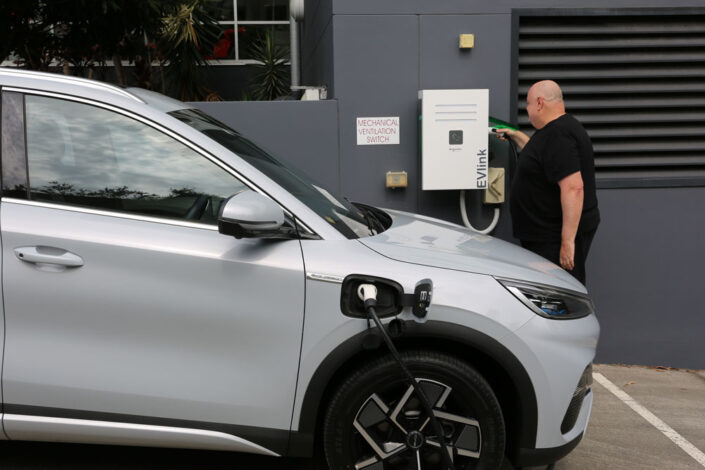I am now over three months into living with the BYD Atto 3 electric vehicle (EV), and with over 6000km now on the odometer, this month I’m looking at my experience with charging – the options, the costs, and other issues that cropped up for me.
Am I still enjoying my time behind the wheel? Yes. The BYD Atto 3 delivers a comfortable ride, the build quality is excellent, and there have been no mechanical or electrical issues. Smooth sailing so far.
While it may not look it, the BYD Atto 3 is quick. People are surprised by its pace, and I seem to be winning more than my fair share of ‘traffic light grand prix’ (up to the speed limit, of course!), which is a bit of fun.
We know BYD has made a significant splash in the local EV market, with the Atto 3 proving to be a popular model with consumers, and I am now seeing a few others on the road. For me, they tend to blend into the sea of other mini-SUVs, but, for the moment at least, they are still rare enough that many people are curious and interested in it at traffic lights and when it is parked up. Maybe it’s the ‘Build Your Dreams’ badging (which can cause a giggle or two) on the tailgate, or the warning ‘hum’ it makes at up to 30km/h that is designed to warn pedestrians there is a moving vehicle nearby.
I am asked about charging regularly by friends, family and work colleagues. How long does it take? Is it an inconvenience? What does it cost?, and have I run out of battery yet (NO!).
Early in my ‘ownership’, while becoming familiar with using a full EV as my daily transport, I was charging every day, but after a few weeks I became more confident in the range offered by the BYD’s 60.4kWh battery (the company claims a range of up to 420km, and that seems just about right). I now am quite confident running the battery down to 20 per cent before looking to charge.
How long that charge takes depends on the charger (AC or DC or a combination), and the rate at which it charges.
BYD supplies owners with a domestic three-pin plug AC charger, which connects to a normal home power point. This method charges at around 1.5 to 2kW and means a charge from 20 per cent to 100 per cent will take more than 24 hours. While charging at home is, obviously, very convenient, if you are driving large distances daily, this method is probably not going to work. I have only done it once, for 8 hours. Good news is the cost would have been negligible.
To charge from a Type 2 charging station – that’s the type that can charge at a higher rate, up to 22kW in some cases – requires the purchase of a Type 2-to-Type 2 charging cable. This was not supplied with our Atto 3 and that cable can cost between $200 and $300.
Type 2 charging is used universally across Australia’s charging network – and is commonly installed at workplaces and homes – and is what I have available at the MTA Queensland head office. An AC charger, it replenishes the battery at a rate of 6.3kW. In my experience this rate takes 7 to 8 hours to charge the BYD from 20 to 100 per cent. Having a charging point at work, at a 6kW+ charging rate, has been very convenient and I use it two to three times a week. There is no wait time, and it is cost-neutral when you take into account the building’s extensive solar panel infrastructure.
Finally, I have used a local (to where I reside) Chargefox network CCS2 combo plug DC charger. This is one the fastest charging types available and is located
at a major shopping centre. This charge point delivers power at 50kW – which is actually less than the maximum 80kW (DC) that the BYD can accept – and at this rate, a 20 per cent to 100 per cent charge takes approximately 75 minutes. The charging rate is also acceptable for a quick battery boost – 20 minutes delivers a 20 per cent charge.
The charger’s location is handy too – a full top-up can be done while completing the shopping. In this situation it is convenient, but there is a price to using it. The time I used it, that cost was $15 to charge from 20 to 100 per cent.
I was lucky in that no one else was using it when I wanted to plug in. However, when I returned, I could see the frustration etched on the face of a Tesla owner who was waiting for his turn.
So, what have the issues been with charging? Well, while these are relevant only to me and my circumstances, I imagine that other EV owners can relate.
- Home charging without a ‘proper’ Type 2 charging point is too slow. I think it makes sense to have one installed.
- My local area only has one CCS2 combo plug DC fast charging port (50kW). The next closest is another 18km away at an Ampol service station where the same charge from 20 per cent to 100 per cent will (at the time of writing) cost $30. That’s almost as expensive per kilometre as my previous company vehicle, a Camry Hybrid.
- The one time I felt I really needed a quick boost (a 15-minute fast charge), my local CCS2 combo plug DC fast charging port was out of order. It was out of order over a month later too.
- After business hours, that charging location is not particularly well lit, located as it is deep in a shopping centre’s under-building car park. At that time, there is no local café in which to sit and wait, there is nobody around and, for me at least, that made me feel a little wary.
- As a general observation, charging infrastructure has yet to catch up with the growing demand and use of EVs.
- On the plus side of things, I haven’t consumed as many coffees and snacks as I thought I might have when waiting for the car to charge!
Joking aside, though finding and using public charging stations can be a little frustrating, I am quite taken by the BYD Atto 3, and EVs in general, and that has led me to research other brands and models on the market. For a V8 enthusiast and amateur motorsport competitor like me, I’ll admit that my research has focused on performance EV models such as the Kia EV6 GT, the Polestar 2 and 3, and the Porsche Taycan. The performance abilities of these does interest me. Could one of them replace one of my own combustion engine performance vehicles?
To help convince me of a change, if anybody has one of those models I could borrow for a while, let me know!
Source: Motor Trader e-Magazine (Mar 2023)
14 March 2023


